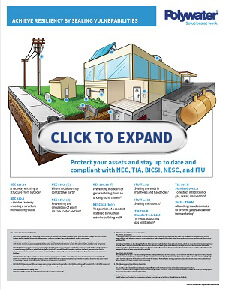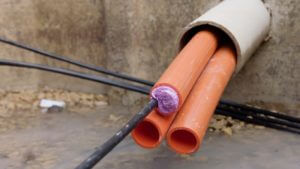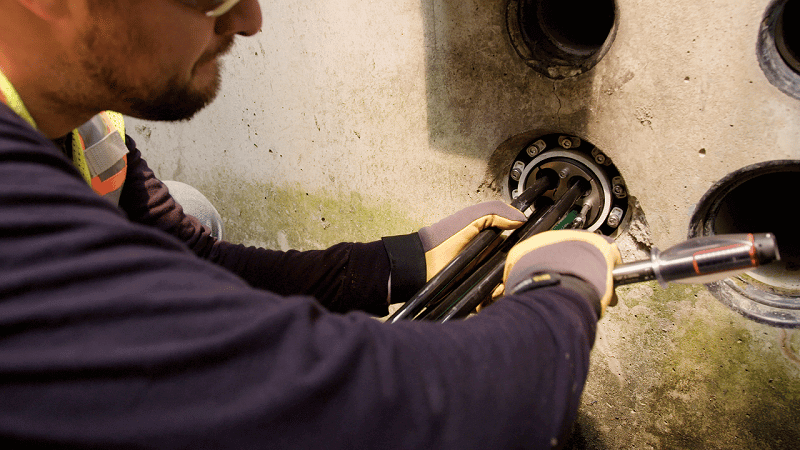Is Meeting a Standard Enough?—An Examination of Duct Sealing Code Compliance.
Numerous international codes and standards exist to mandate that electrical and communication conduits be sealed. Duct seals provide relatively inexpensive prevention against costly and potentially catastrophic cable and equipment damage. Their function is primarily to block water ingress, but also gases, fire, dust, pests, or other materials that could harm utility infrastructure and cause service outages. However, an important and often overlooked question is whether such mandates provide adequate guidance for installers on what exactly constitutes a compliant and, more to the point, functional seal. This article explores the difference between best practices and the vital role of code enforcement.
What the Codes Say:
The infographic linked here and also found below, illustrates the need for duct seals and lists various governing standards. Let’s review the language in a sampling of pertinent electrical and communication industry codes from around the world:
NEC 225.27 Raceway Seal:
“Where a raceway enters a building or structure from outside, it shall be sealed. Spare or unused raceways shall also be sealed. Sealants shall be identified for use with cable insulation, conductor insulation, bare conductor, shield, or other components.”
NEC 230.8 Raceway Seal:
“Where a service raceway enters a building or structure from an underground distribution system, it shall be sealed in accordance with 300.5(G). Spare or unused raceways shall also be sealed. Sealants shall be identified for use with the cable insulation, shield, or other components.”
NEC 300.5 (D)) G) Raceway Seals:
“Conduits or raceways through which moisture may contact live parts shall be sealed or plugged at either or both ends. Spare or unused raceways shall also be sealed. Sealants shall be identified for use with cable insulation, conductor insulation, bare conductor, shield, or other components.”
| Related Content: Sealing Conduits for Resilient Electrical and Telecommunication Systems |
NEC 300.7 (A) Sealing:
“Where portions of a raceway or sleeve are known to be subjected to different temperatures, and where condensation is known to be a problem, as in cold storage areas of buildings or where passing from the interior to the exterior of a building, the raceway or sleeve shall be filled with an approved material to prevent the circulation of warm air to a colder section of the raceway or sleeve. An explosion proof seal shall not be required for this purpose.”

NEC 300.50 (F) Raceway Seal:
“Where a raceway enters from an underground system, the end within the building shall be sealed with an identified compound so as to prevent the entrance of moisture or gases, or it shall be so arranged to prevent moisture from contacting live parts.”
NEC 501.15 (B)(2) Conduit Seals, Class 1 Division 2:
“A conduit seal shall be required in each conduit run leaving a Class 1, Division 2 location… and it shall be designed and installed to minimize the amount of gas or vapor within the portion of the conduit installed in the Division 2 location… Such seals shall not be required to be explosion proof…”
NESC 322 (b)(4):
“The portion of a conduit installed through an exterior building wall, floor, or roof shall have seals inside the conduit and external seals on the outside surface of the conduit at the point of entry to the building intended to limit the likelihood of the entrance of gas into the building. The use of seals may be supplemented by gas-venting devices in order to minimize building up of positive gas pressures in the conduit.”
ITU Rec. ITU-T L.92:
“… sealing the ends of the plastic tubes (at the manholes/pits of our underground infrastructure) with foam filler. Outside plant facilities are also damaged by floods. Water can enter manholes, hand-holes and cable tunnels, which can cause telecommunication equipment to break down. Therefore, manholes and hand-holes are required to be water tight. Cables entering or exiting a manhole or hand-hole have to be sealed.”
| Related Content: Duct Seals Prevent Ruinous Water Damage |
ITU Rec. ITU-T L.162:
“It is mandatory to use pipe – microduct sealing elements (sealing between pipe and microducts), in order to ensure … the seal against the entry of liquids and gases … to protect the branch of microducts. Microcable should be sealed to the microduct both in the cable chamber adjacent to the building as well as inside the building. The installation of empty (spare) microducts that do not contain microcables, should also be sealed in the cable chamber, inside the building.”
TIA-758-B Standard 5.1.1.2.8:
“Ducts shall be sealed to resist liquid and gas infiltration at all maintenance holes and building entrance point locations.”
TIA-758-B Standard 5.4.2.3:
“All conduits shall be plugged to restrict infiltration of gas, water, and vermin.”
BICSI-TDMM:
“Seal all underground conduits to prevent gases and water from entering the building or other MHs via the ductbank.”
DIN 18322:2019-09 3.7.2:
“Cable and conduit entries shall be tightly sealed so as to be watertight and gastight.”
DIN 18322:2019-09 4.2.6:
“Sealing of conduits after cables, etc. have been laid.”
CEC Rule J18-108:
“… requires that conduit seals be installed in conduit systems where …”
| Related Content: “Let’s Talk Cabling” Video Podcast: Best Way to Seal OSP Conduit |
What the Codes Don’t Say
The codes are essentially material specs; they require that ducts are sealed with some material. But they aren’t specific as to what that material must be. Only one calls for the use of “foam filler”. But it doesn’t describe which of the nearly infinite number of foam variations should be used (e.g., open-cell, closed-cell, urethane-based, epoxy-based, etc.). The others generally leave the material choice to discretion. That allows not only for the use of any type of foam, but also other chemicals, such as duct putty. It also allows for the use of non-chemical materials such as mechanical seals. Even a wad of old rags may be interpreted as compliant. Sometimes the choices come with costly consequences.
Material Spec vs. Performance Spec
Few of the codes, particularly those relating to non-mechanical seals for water or gas, are considered performance specs. Other than a few requiring that the sealant “be identified for use with” ducts and cables—in other words, compatible—they list no specific test or performance criteria to meet. They establish no quantitative thresholds or time limits to which a seal must perform. For example, they don’t state what level of water head pressure must be resisted, or how much gas pressure in psi a seal must hold. There are no ASTM, IEEE, UL, CSA, or other common testing regimes to follow.
What Could Go Wrong?
Problems can arise when installers use cheap, readily available sealing products that ostensibly meet a governing standard, but in practice don’t produce effective or long-lasting seals appropriate for the circumstance. Most common is the use of duct putty or one-part aerosol “gap and crack” foams from DIY stores. Duct putty sags over time, rendering it unsuitable as a long-term solution. Open-cell foams are versatile but not appreciably watertight or airtight. A seal that passes inspection only to fail shortly thereafter—or later when the crisis is at hand—isn’t really a seal. Costs related to seal failure often don’t end with the cables, electrical apparatus, and telecommunications equipment damaged; they extend as well to the resulting service outages.
| Related Content: Understanding and Mitigating Manhole Explosions: An Interview with Stuart Hanebuth |
What Is the Solution?
 The codes are crucial in their requirement to seal conduit entrances, but more guidance is needed to ensure effective seals because merely meeting a standard doesn’t guarantee that a seal will protect valuable assets from water, gas, rodents, dirt, or fire. Many installers (inspectors too) are unaware of the shortcomings of duct putty and open-cell foams. They naturally gravitate to the easiest and lowest-cost product, believing the code is met.
The codes are crucial in their requirement to seal conduit entrances, but more guidance is needed to ensure effective seals because merely meeting a standard doesn’t guarantee that a seal will protect valuable assets from water, gas, rodents, dirt, or fire. Many installers (inspectors too) are unaware of the shortcomings of duct putty and open-cell foams. They naturally gravitate to the easiest and lowest-cost product, believing the code is met.
The solution is for performance-based specifications in system design and best practices. Specifiers and engineers should analyze situational risks and establish performance criteria for effective seal integrity. Sealants should be sourced from reputable manufacturers offering products developed, tested, and rated specifically for conduits. Duct seal selection should be an informed process based on the risk profile of the application and the well-tested technical specifications of the chemical or mechanical sealing product.
